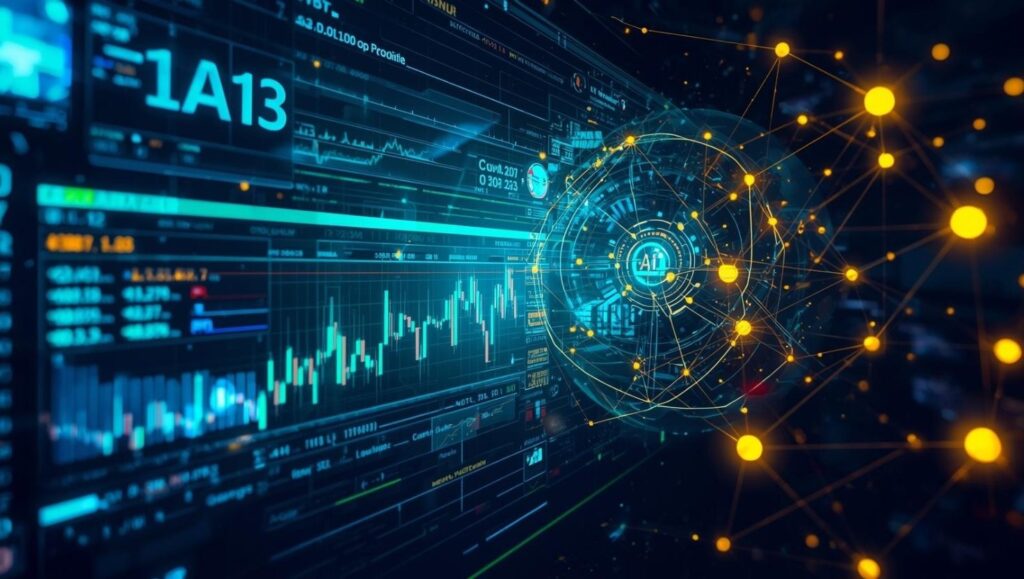Artificial intelligence is no longer a futuristic concept in finance. It is already transforming how money moves, how investments are made, and how fraud is prevented. From trading floors in New York to digital banks in Singapore, AI has become the invisible force driving profits and protecting assets. The financial sector, worth trillions of dollars, is now competing in a race where the fastest learner wins, and the learner is often not human.
A Story from the Trading Floor
In early 2025, an investment firm in Singapore made headlines in industry circles when one of its AI-powered bots executed thousands of trades in less than a minute, generating a profit of nearly four million dollars before human traders had even logged into their terminals. This was not luck or a glitch. The bot had analyzed global market sentiment, scanned hundreds of news reports, and factored in social media conversations overnight. By the time human traders woke up, the bot had already capitalized on a surge in demand for energy futures.
This case illustrates the new reality of algorithmic trading. Machines no longer just follow instructions; they think, adapt, and anticipate.
Algorithmic Trading: The New Superpower
Traditional algorithmic trading relied on static rules, but AI has given it intelligence and adaptability. Machine learning models now use reinforcement learning, a method where algorithms continuously refine their strategies by learning from past successes and failures. Instead of waiting for human intervention, these systems adjust in real time to market fluctuations.
According to Bloomberg Intelligence, AI-driven trading now accounts for over 70 percent of equity trading in the United States. Hedge funds and asset managers are using deep learning models to predict market movements not just from charts, but from unstructured data like political speeches, regulatory announcements, or even sudden weather events that could disrupt supply chains.
A live use case comes from JPMorgan Chase’s AI trading platform LOXM, which has been upgraded to autonomously execute large equity trades with minimal market disruption. The system learns market behavior over time, making decisions that reduce costs and improve efficiency.
Fraud Detection: AI as the Digital Guardian
While trading gets most of the spotlight, fraud detection may be AI’s most impactful role in finance. In 2024, global financial fraud losses crossed 40 billion dollars, fueled by scams ranging from phishing to synthetic identity theft. AI is now the sector’s frontline defense.
Neural networks and anomaly detection systems can spot unusual behavior such as a sudden transfer from a dormant account at midnight or multiple logins from different geographies within minutes. Predictive AI models not only detect fraud in progress but anticipate it before it happens.
A powerful example comes from Mastercard, which uses AI to analyze over 125 billion transactions annually. Their systems identify anomalies within milliseconds, blocking fraudulent activity before customers even realize something was wrong. In one case, Mastercard’s AI stopped a large-scale fraud attempt that targeted thousands of cards simultaneously—saving millions of dollars in potential losses.
The Human-AI Collaboration
The rise of AI in finance does not mean humans are obsolete. Instead, it signals a new partnership. Traders, analysts, and fraud investigators are working alongside intelligent systems that do the heavy lifting at speeds humans cannot match. The human role shifts from execution to oversight, strategy, and ethical governance.
A fascinating example is how Goldman Sachs uses AI to process massive amounts of client data, but still relies on human advisors to interpret insights and make relationship-driven decisions. In this model, AI provides the horsepower, but humans provide the trust.
Challenges and Risks
The opportunities are enormous, but the risks are equally significant. AI trading systems have been linked to flash crashes when algorithms overreact to sudden signals. Fraud detection systems can sometimes create false positives, frustrating legitimate customers. Regulators are also concerned about transparency—how do you audit a black-box algorithm that moves billions of dollars in trades?
Governments are responding. The European Union’s AI Act, passed in 2024, sets clear compliance standards for AI in financial markets. The United States Securities and Exchange Commission (SEC) is also working on guidelines for algorithmic accountability in trading. The message is clear: AI must be powerful but also transparent and fair.
The Future: Smarter Markets and Safer Money
The story of that Singapore investment firm and the success of fraud detection at Mastercard highlight where finance is headed. AI is not just a tool—it is becoming the backbone of financial systems. We can expect the future to bring:
- Real-time fraud prevention across digital wallets and crypto transactions.
- AI-driven investment strategies personalized to individual investors.
- Global regulatory frameworks to ensure AI-driven finance is safe and ethical.
AI in finance is both an opportunity and a responsibility. The winners will be the firms that embrace the intelligence of machines while ensuring trust, compliance, and human oversight.
Conclusion
The financial sector is standing on the edge of an AI-powered revolution. Algorithmic trading has become a superpower that reacts in milliseconds, while AI-driven fraud detection acts like a digital watchdog protecting billions of people. The small story of that Singapore firm shows how quickly fortunes can be made, and Mastercard’s use case proves how much can be saved when fraud is stopped in its tracks.
The truth is simple. In the finance world of tomorrow, the smartest minds will no longer sit only in boardrooms or trading desks. They will run on servers, learn at scale, and operate tirelessly as artificial intelligence. And those who harness this power responsibly will shape the future of money itself.


